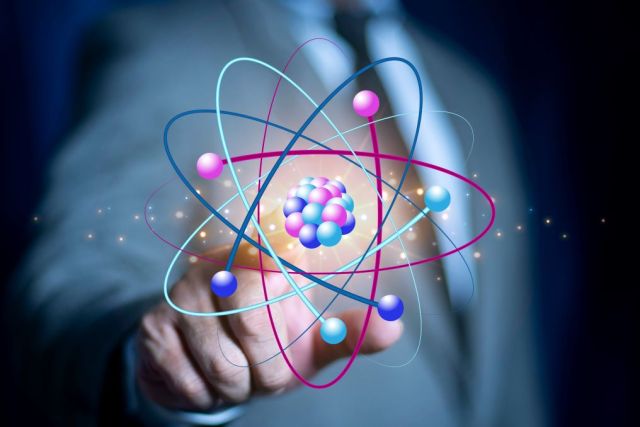
Nano Nuclear isn’t the only company working to develop microreactors. Others include California-based Oklo Inc. and Westinghouse. (Source: Shutterstock)
Nano Nuclear Energy is on a mission to develop microreactors and pull ahead of the competition in its niche market, swooping into areas in the U.S. where small-scale nuclear makes the most sense.
But the company, which in May became the first publicly listed portable nuclear microreactor company in the U.S., is still early in its journey. Nano Nuclear is designing and developing small-scale nuclear fission reactors—called Zeus and Odin. However, it may be several more years before they become commercially available, sooner if new federal regulatory measures expedite the licensing timeline and make way for quicker deployment.
Still, the technology’s potential is already piquing interest as the company attracts capital and signs memorandums of understanding with companies, including data center operator Blockfusion USA Inc., to explore advanced microreactors for power.
“The good part about nuclear in general is that it can be put anywhere,” James Walker, CEO of Nano Nuclear said.
Plus, it is not dependent on optimal weather conditions and has a higher capacity factor than renewables, including geothermal, he added.

The same can be said of oil and gas. With microreactors, “you can supply small levels of power. … If you need one megawatt [MW], you go to microreactor. If you need five megawatts, you’ve got a slightly bigger microreactor. If you need 20 MW as well, you’ve got a small modular reactor.”
And, if the site is in the middle of nowhere, as Walker put it, power and transmission lines are not needed.
With capacities of less than 50 MW, microreactors have been gaining attention in the energy industry as companies seek around-the-clock, emissions-free, baseload dispatchable power. The focus comes amid the persistent drive to decarbonize while maintaining reliable, affordable access to power.
RELATED
The Nuclear Option: E&Ps See Promising Yield from Mobile Reactors
Nuclear in a Box: Mobile Nuclear Reactors May Answer Permian’s Power Ask
Unlike small modular reactors, which typically produce about 300 MW, and the much larger conventional nuclear plants that produce gigawatts of power, microreactors have smaller footprints, are mobile and have lower costs. Oil and gas producers are among the companies considering microreactors to power their operations.
The technology
When Nano Nuclear set out to design its microreactors, the company was set on going small so that the equipment could fit anywhere, Walker said.
“We had to constrain the dimensions of the reactor to an ISO container that contained not just the reactor itself, but also the conversion system, the turbine, to produce the electricity as well,” he said. “So, we had to go small.”
Two teams took different approaches. Designs for two microreactors emerged: the Zeus solid core battery reactor and the Odin low-pressure coolant reactor. Both are portable, advanced nuclear microreactors, the company said.
“The Zeus reactor [team] decided that if it was to remove the primary coolant completely and slowly conduct the heat through a solid core, they could reduce the mechanical complexity and the electromechanical complexity of the reactor enormously, remove pumps and other things. And it would shrink right down,” Walker said. “And the Odin reactor team realized that if they took license fuels and off-the-shelf components and high TRI-level components, they could produce a reactor that could fit within an ISO container and be deployed very quickly and be easier to license.”

Designed to fit inside of a 45 ft-tall cube container, Zeus features a power conversion unit capable of generating 1 MW to 2 MW of electricity without fluid coolant, Nano said on its website. Odin is designed to use conventional fuel with up to 20% enrichment.
Both reactors are currently being developed. The company has completed the preconceptual and conceptual designs of the microreactors. Next up is physical test work such as building rigs, buying materials and running tests that includes thermal conduction tests on those materials to see whether they can withstand heat, Walker said.
The components can be 3D printed and assembled very cheaply, he added. The Zeus microreactor has a tractor-trailer type setup, with the reactor sitting on a trailer hooked up to a tractor. The intent is for the microreactors to be easily deployed—requiring only one or two people to operate—and be monitored remotely.
The microreactor journey
The company plans to spend about two or three years collecting and developing data before moving ahead into the licensing process.
“At the end of this phase currently that we’re in, this physical phase, we’ll have a prototype by the end of it. So maybe a couple years’ time … we’ll take the reactor to the licensing,” Walker said. “That would take between three and four years, and then we should have a product hopefully ready to go out the door sometime around about 2031.”
The Advanced Nuclear for Clean Energy (ADVANCE) Act could accelerate the deployment time, he added.
With bipartisan support, the ADVANCE Act was signed into law by President Joe Biden in July. It directs the Nuclear Regulatory Commission (NRC) to lower certain licensing application fees for advanced nuclear reactor application reviews, authorizes more staff to carry out reviews and introduces prize competitions to incentivize deployment of advanced reactor technology. It also directs the NRC to develop guidance to license and regulate microreactor designs within 18 months.
Nano Nuclear isn’t the only company working to develop microreactors. Others include California-based Oklo Inc. and Westinghouse.
Westinghouse is developing the eVinci microreactor, which can produce 5 MW equivalent with a reactor core designed to run for eight full-power years or more before refueling.
Oklo, which signed a 20-year power purchase agreement with Diamondback in April and secured a $10 million investment last year from Liberty, is developing advanced fast fission reactors running on fresh fuel or recycled nuclear waste. Its microreactor, which uses liquid metal sodium as a coolant, will be available in three sizes: 15 MW, 50 MW and 100+ MW, according to the company’s website. The company also went public this year.
The microreactors’ developers are targeting data centers, oil and gas producers and industrial users, among others.
Nano Nuclear has had ongoing talks with a couple of companies in the oil and gas industry, including about potential microreactor deployment offshore, Walker said.
A nuclear future?
So far, none of the microreactor developers have received commercial approval from the U.S. Nuclear Regulatory Commission. The journey is not expected to be quick or smooth sailing as regulators assess these new reactors.
“The licensing period for nuclear is so long and so onerous that it can add on hundreds of millions of dollars to the capital cost and actually be much more than the whole development of the reactor,” Walker said.
Reforms are in place to address that, he said. The regulatory process is not as burdensome in China, where nuclear is cheaper than natural gas.
“They’re producing a lot of these reactors. They’re scaling them and they don’t have that long regulatory timeline,” Walker said of China. “So, nuclear can be commensurate. It can actually be the cheapest form of energy in the world.”
In the U.S., nuclear developments typically have high upfront capital costs that require a lot of financing.
Microreactors are expected to have a lower price tag compared to expensive conventional gigawatt-scale nuclear power plants. Depending on the size, small reactors can cost about $50 million for microreactors, according to the Cleantech Group. That compares to billions of dollars needed to construct a new nuclear power plant.
Nano Nuclear went public in May, listing on the Nasdaq Capital Market and closing an IPO of about $10.3 million.
“We were offered a significant amount of money to stay private. But we turned it down to go this route so we could grow with the public over time,” Walker said.
Going public put the company in a better position to develop, he said. “Being able to demonstrate that you can raise significant capital to develop the company adds credibility to the company.”
It has also brought more scrutiny, including a class action lawsuit by investors alleging securities fraud. The suit alleges Nano Nuclear overstated its financial position and made no progress toward regulatory approval for the design of its planned microreactors, among other claims.
Nano disputes the allegations.
Speaking before the suit was filed, Walker said “they’re ambulance chasing firms. … No laws have been broken. Nothing. No SEC [Securities and Exchange Commission] investigation. Nothing. It’s a lot of smoke and mirrors to create uncertainty in the market, to drive the stock down, to profit from the hedge fund. And unfortunately, we just got to go through it. We’ve actually got a wonderful business.”
Looking ahead, Walker sees an opportunity to become a cornerstone in the industry, given government and industry support for nuclear.
Enormous amounts of money are going into nuclear, but the fuel supply chain needs to be built up along with the atrophied infrastructure, Walker said on a potential rebirth of nuclear in the U.S.
“It could be, provided we can get that infrastructure rebuilt, get everything in place, we’ll have that renaissance and we should all benefit from it in the long run,” he said.
Recommended Reading
Pembina Closes $290MM Deal for Stake in Whitecap’s NatGas Facility
2025-01-02 - Pembina Gas Infrastructure closed a CA$420 million transaction to acquire interests in Whitecap Resources’ natural gas processing facility in Alberta, Canada.
Nabors SPAC, e2Companies $1B Merger to Take On-Site Powergen Public
2025-02-12 - Nabors Industries’ blank check company will merge with e2Companies at a time when oilfield service companies are increasingly seeking on-site power solutions for E&Ps in the oil patch.
DNO to Buy Sval Energi for $450MM, Quadruple North Sea Output
2025-03-07 - Norwegian oil and gas producer DNO ASA will acquire Sval Energi Group AS’ shares from private equity firm HitecVision.
Diamondback Acquires Permian’s Double Eagle IV for $4.1B
2025-02-18 - Diamondback Energy has agreed to acquire EnCap Investments-backed Double Eagle IV for approximately 6.9 million shares of Diamondback and $3 billion in cash.
Obsidian to Sell Cardium Assets to InPlay Oil for US$225MM
2025-02-19 - Calgary, Alberta-based Obsidian Energy is divesting operated assets in the Cardium to InPlay Oil for CA$320 million in cash, equity and asset interests. The company will retain its non-operated holdings in the Pembina Cardium Unit #11.
Comments
Add new comment
This conversation is moderated according to Hart Energy community rules. Please read the rules before joining the discussion. If you’re experiencing any technical problems, please contact our customer care team.






